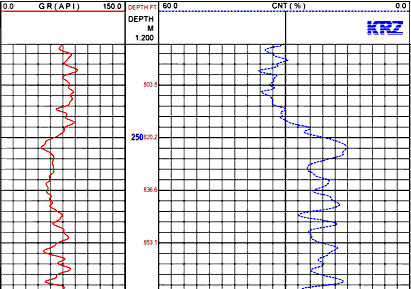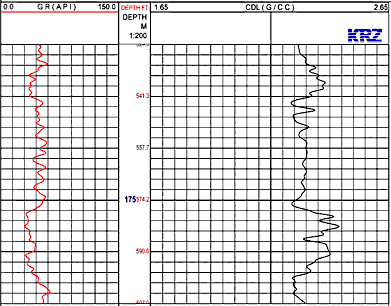|
[20/03/2007]
NUCLEAR TOOLS GENERAL
One of the most important parameters required for evaluation of
a potential oil or gas reservoir is porosity. Porosity is
defined as the pore volume per unit volume of formation. In
addition to the resistivity measurements discussed in the
previous section, knowledge of the amount of pore space within
the formation is required for accurate formation evaluation.
Several different types of tools have been developed to evaluate
formation porosity compensated density, litho-density with Pe
measurement compensated neutron, and BHC sonic tools. Although
all four respond to formation porosity, each responds in a
different manner. Therefore, combinations of two or three types
of porosity tools provide much more information about porosity,
lithology, and rock properties. The combination of density and
neutron tools can distinguish between oil and gas in the pore
space in known lithologies. The combination of litho-density and
compensated neutron log remove ambiguity about gas effect or
lithology effect in unknown lithologies.
The combination of density and sonic data is used to produce
synthetic seismic traces so that seismic data may be correlated
to the well log data and depth points assigned to that well in
the seismic data view.
The data from the resistivity logs and several porosity logs can
be combined so that complex analytical computations can be
completed giving you a rapid and accurate evaluation of your
well on site. The following descriptions are of tools used for
porosity determination.
THEORY OF COMPENSATED NEUTRON (CNT)
The CNT uses a radioactive source to bombard the formation with
high-energy neutrons. The high-energy neutrons are slowed to
thermal energy by the formation. For the most part, this change
in energy level is caused by collision with hydrogen atoms. Two
proportional detectors count the slow (thermal) neutrons
deflected back to the tool. The use of two detectors provides
compensation to overcome many of the limited of other neutron
tools. As a result, the CNT is less influenced by borehole
effects.

Tool readings depend mostly on the hydrogen content of the
formation - a function of the amount of water and / or
hydrocarbons in the pore space.
Since gas has less hydrogen per unit volume than either oil or
water, the CNT differentiates between gas zones and those filled
with water and / or oil. This characteristic makes the CNT an
excellent gas indicator when its readings are compared with
those of other porosity tools.
The CNT is used only in liquid filled open or cased-holes.
The principal uses of the CNT are :
> For porosity analysis, to provide data for computation of
water solution.
> For lithology, identification when combined with other logs.
> To aid gas determination when combined with other porosity
logs. As a shale volume indicator.
COMPENSATED NEUTRON (9073)
The Compensated Neutron Tool (CNT-9073) in combination
with other sensors at same tool package.
The
Compensated Neutron tool contains a two detector, neutron system
which uses a 5.0 Curie, Am241Be source to record neutron
porosity of the formation. Additionally, the tool also records
short and long neutron counts, natural gamma and a deep guard
resistivity.
Transmission of the data to the surface is accomplished with the
use of a digital telemetry
which encodes the data for transmission and time multiplexes the
signals with other sensors.

Specifications
|
Dimension |
|
|
|
Tool Length |
283.5 cm |
111.6 in |
|
Diameter |
5.08 cm
|
2.0 in |
|
Weight |
25 kg
|
55 lb |
Offset Parameter
|
Sensor # |
Tipe of
Sensor |
Offset |
|
1 |
Gamma Ray |
30.5 cm
|
12 in |
|
2 |
Deep Guard |
152.4 cm
|
60 in |
|
3 |
Far Neutron |
209.8 cm
|
82.6 in |
|
4 |
Near Neutron |
246.4 cm
|
97 in |
Operation Parameter
|
Parameter |
|
|
|
Max
Temperature |
85 C
|
185 F |
|
Max Pressure |
232 kg/cc
|
3300 PSI |
|
Logging Speed |
9 m/min |
30 ft./min |
|
Tool Voltage |
70 VDC |
|
|
Radioactive
Usage (6) |
5 Ci |
AmBe241 |
|
RA handling tool |
Source handling tool |
|
Calibrator |
Water Tank |
85 API GR
blanket |
| |
Mixture Resistivity Box |
THEORY OF LITHO DENSITY (LDT)
The Litho Densty Tools provides measurements of formation
density, and in addition, it also treasured the photoelectric
absorption index expressed a photoelectric factor (PEF) of the
rock
As a result the PEF measurement depends predominately on the
atomic number of the material composing the formation.
Consequently, PEF is closely related to the Iithology of the
formation and allows better evaluations in intervals of unknom
Iithology and complex lithology
The LDT is normally run in combination with the CNT and GR to
provide determination of
>> Effective Porosity
>> Lithology
>> Gas Zones
>> Mineral identification

COMPENSATED DENSITY (CDT-9039)
The compensated Density TooI measures the density of the
formations panetrated by the borehole. The term 'bulk density is
used because the density measured includes the density of the
fluid in the pore spaces as well as the grain density of the
rock The CDT utilizes two defectors to compensate bulk denstiy
mesurements for mud-cake and hole rugosity. A compensation curve
is distalayed on the log to indicate the amount of correction
applied to the recorded bulk density The density tool is held
against one side of the borehole by a spring, which also served
as a caliper. The CDT is an excellent for measuring porosity for
any gas or liquid Filled uncased hole.
The
9039 tool contains a two detector, focused density system using
a 1Ci Cesium 137 source, to record apparent bulk density of the
formation.
Additionally, the tool also records natural
gamma, caliper, and a short guard resistivity.
Transmission of the data to the surface is accomplished with the
use of a digital telemetry
which encodes the data for transmission and time multiplexes the
signals with other sensors.

Specifications
|
Dimension |
|
|
|
Tool Length |
280.3 cm
|
110.35 in |
|
Diameter |
56 mm
|
2.2 in |
|
Weight |
29.5 kg
|
65 lbs |
Offset Parameter
|
Sensor # |
Tipe of
Sensor |
Offset |
|
1 |
Gamma Ray |
21 cm |
8.25 in |
|
2 |
Short Guard |
63.5 cm
|
25 in |
|
3 |
Caliper |
210.8 cm
|
83 in |
|
4 |
Far Density |
243.3 cm
|
95.8 in |
|
5 |
Near Density |
259.3 cm
|
102.1 in |
Operation Parameter
|
Parameter |
|
|
|
Max
Temperature |
74 C |
158 F |
|
Max Pressure |
175 kg/cm2
|
2500 PSI |
|
Logging Speed |
9 m/min |
30 ft./min |
|
Tool Voltage |
56 VDC |
|
|
Radioactive
Usage (6) |
1 Ci |
Cs 137 |
|
RA handling tool |
Source handling tool |
|
Calibrator |
Water Tank |
85 API GR
blanket |
| |
Mixture Resistivity Box |
The principal uses of the CDT are :
• For porosity analysis, to provide data for water saturation
calculations
• For Iithology identification when combined with other porosty
logs
• To aid in gas determination when refrained with a neutron log
• Provides a caliper measurement
|